The NVIDIA GeForce GTX 980 Ti Review
by Ryan Smith on May 31, 2015 6:00 PM ESTCompute
Shifting gears, we have our look at compute performance. Since GTX Titan X has no compute feature advantage - no fast double precision support like what's found in the Kepler generation Titans - the performance difference between the GTX Titan X and GTX 980 Ti should be very straightforward.
Starting us off for our look at compute is LuxMark3.0, the latest version of the official benchmark of LuxRender 2.0. LuxRender’s GPU-accelerated rendering mode is an OpenCL based ray tracer that forms a part of the larger LuxRender suite. Ray tracing has become a stronghold for GPUs in recent years as ray tracing maps well to GPU pipelines, allowing artists to render scenes much more quickly than with CPUs alone.
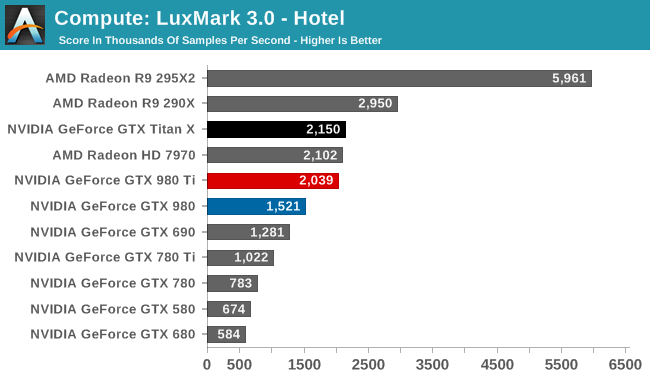
With the pace set for GM200 by GTX Titan X, there’s little to say here that hasn’t already been said. Maxwell does not fare well in LuxMark, and while GTX 980 Ti continues to stick very close to GTX Titan X, it none the less ends up right behind the Radeon HD 7970 in this benchmark.
For our second set of compute benchmarks we have CompuBench 1.5, the successor to CLBenchmark. CompuBench offers a wide array of different practical compute workloads, and we’ve decided to focus on face detection, optical flow modeling, and particle simulations.
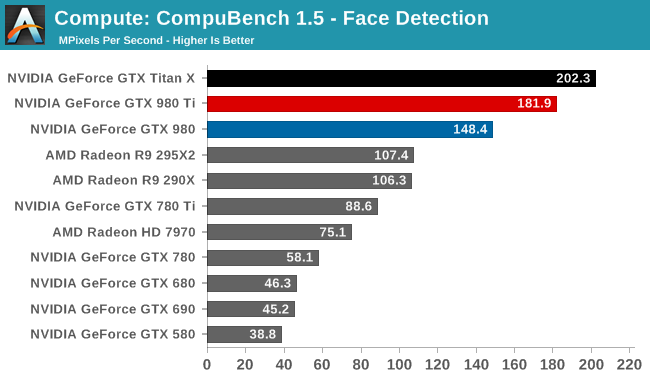
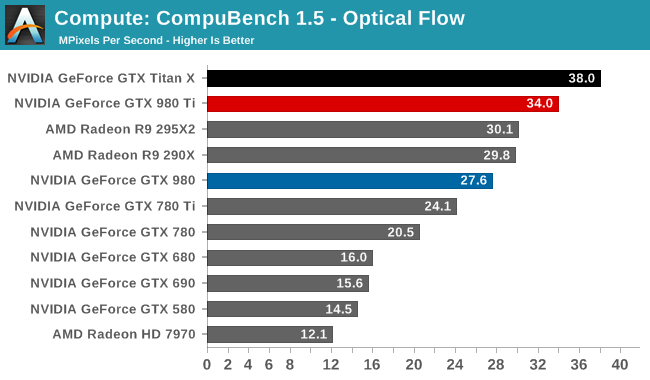
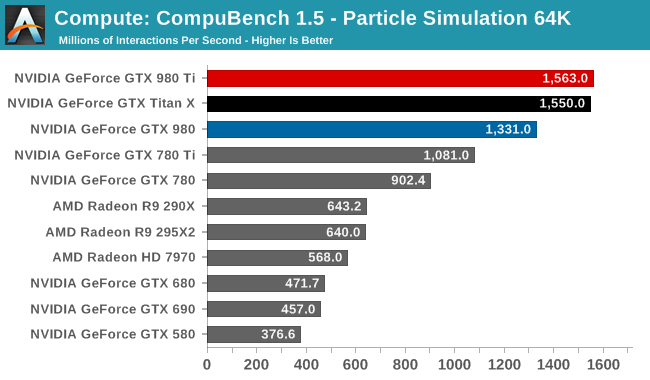
Although GTX T980 Ti struggled at LuxMark, the same cannot be said for CompuBench. Though taking the second spot in all 3 sub-tests - right behind GTX Titan X - there's a bit wider of a gap than normal between the two GM200 cards, causing GTX 980 Ti to trail a little more significantly than in other tests. Given the short nature of these tests, GTX 980 Ti doesn't get to enjoy its usual clockspeed advantage, making this one of the only benchmarks where the theoretical 9% performance difference between the cards becomes a reality.
Our 3rd compute benchmark is Sony Vegas Pro 13, an OpenGL and OpenCL video editing and authoring package. Vegas can use GPUs in a few different ways, the primary uses being to accelerate the video effects and compositing process itself, and in the video encoding step. With video encoding being increasingly offloaded to dedicated DSPs these days we’re focusing on the editing and compositing process, rendering to a low CPU overhead format (XDCAM EX). This specific test comes from Sony, and measures how long it takes to render a video.

Traditionally a benchmark that favors AMD, GTX 980 Ti fares as well as GTX Titan X, closing the gap some. But it's still not enough to surpass Radeon HD 7970, let alone Radeon R9 290X.
Moving on, our 4th compute benchmark is FAHBench, the official Folding @ Home benchmark. Folding @ Home is the popular Stanford-backed research and distributed computing initiative that has work distributed to millions of volunteer computers over the internet, each of which is responsible for a tiny slice of a protein folding simulation. FAHBench can test both single precision and double precision floating point performance, with single precision being the most useful metric for most consumer cards due to their low double precision performance. Each precision has two modes, explicit and implicit, the difference being whether water atoms are included in the simulation, which adds quite a bit of work and overhead. This is another OpenCL test, utilizing the OpenCL path for FAHCore 17.
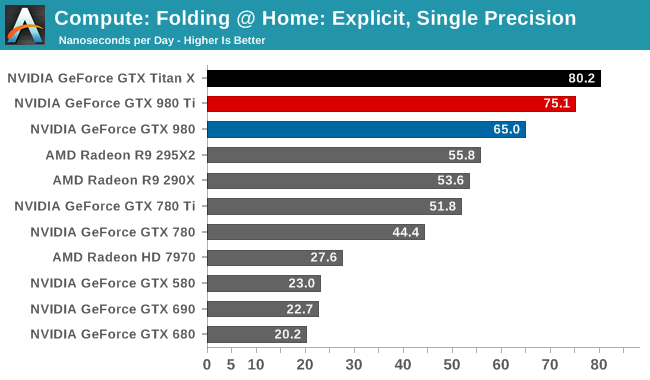
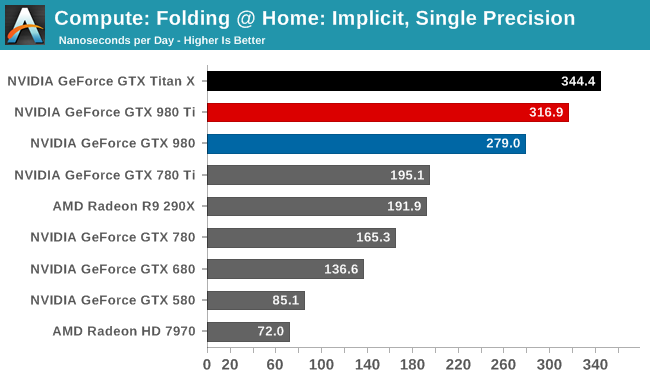
Folding @ Home’s single precision tests reiterate GM200's FP32 compute credentials. Second only to GTX Titan X, GTX 980 Ti fares very well here.
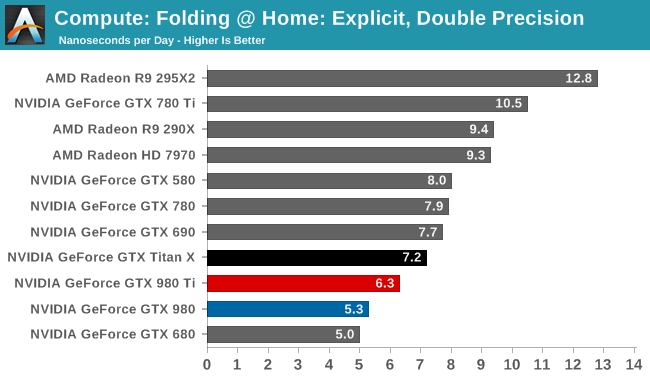
Meanwhile Folding @ Home’s double precision test reiterates GM200's poor FP64 compute performance. At 6.3ns/day, it, like the GTX Titan X, occupies the lower portion of our benchmark charts, below AMD's cards and NVIDIA's high-performnace FP64 cards.
Wrapping things up, our final compute benchmark is an in-house project developed by our very own Dr. Ian Cutress. SystemCompute is our first C++ AMP benchmark, utilizing Microsoft’s simple C++ extensions to allow the easy use of GPU computing in C++ programs. SystemCompute in turn is a collection of benchmarks for several different fundamental compute algorithms, with the final score represented in points. DirectCompute is the compute backend for C++ AMP on Windows, so this forms our other DirectCompute test.

We end up ending our benchmarks where we started: with the GTX 980 Ti slightly trailing the GTX Titan X, and with the two GM200 cards taking the top two spots overall. So as with GTX Titan X, GTX 980 Ti is a force to be reckoned with for FP32 compute, which for a pure consumer card should be a good match for consumer compute workloads.










290 Comments
View All Comments
Casecutter - Tuesday, June 2, 2015 - link
Nvidia places the TitanX in play just so that logic works... But when you pull TitanX from the equation, and work from the 980 (GM204) a 20% increase in FpS for, almost 20% more money, and use 28% more power. It look really humdrum.Kutark - Wednesday, June 3, 2015 - link
You felt the need to post basically the same comment in 2 different places?Regardless you're cherry picking data. Overall its about a 30% increase in perf, for about a 30% increase in price. Its still a "good" deal if you want a powerful single GPU.
uglyduckling81 - Tuesday, June 2, 2015 - link
I'm still shocked at how much the 295x2 kills it. It's so much more powerful that even a Titan X. Newegg had the 295x2 on a sale for $550 2 weekends ago as well. Crossfire driver issues aside if your in the market for the high end I just don't see how you could go past the much more powerful and cheaper 295x2. If I had been in the USA with that $550 sale going I would of snapped that up so fast. Hell I would of bought several and sold a couple when I got home. Those cards are still $1600 in Australia.mapesdhs - Wednesday, June 3, 2015 - link
Really? CF issues aside?? It's a freakin' CF card! What the heck is the point in buying the thing if CF support just doesn't work properly for so many games? And did AMD ever fix DX9/CF issues? Still sucks the last time I tested 7970 CF. Feel free to whack your power bill with the 295x2, spew out heat, etc. Every time I see a crazy extended power usage graph just so the enormous line for the 295x2 can be included, it blows my mind that people ever bother buying it. One person from OZ here commented that heat output is of primary concern where he lives, so chucking out so much heat from a 295x2 would be a real problem. I noticed the same thing with 580 SLI, sooo glad I eventually switched to a single 980.CiccioB - Thursday, June 4, 2015 - link
The fact that a supposedly more powerful card is sold at a lower price should automatically raise you some questions... it is not that because 290x2 is a single card that all crossfire problems magically go away.Drive issue apart is not an option. Crossfire and SLI performances depend heavily on driver quality. And, sorry, but AMD dual GPUs cards have always been the worst choice since they were created.
See what is the support for 7990 cards. 690 cards are still supported as you can see in these very benchmarks.
Moreover, if you want a better dual configuration with support done as one would expect for the spent money, you can just buy 2x GTX970 and live much more happily. Consuming much more less. Dual GPU comparison here is not even to take into account. The simplicity, scaling and smoothness of a single GPU like Titan X or this GTX980TI simply crush the dual GPU competition without any doubt, even though they do some FPS less as average.
If you cannot understand that, it is right that you continue buying crappy cards and be happy with those.
NvidiaWins - Wednesday, June 3, 2015 - link
Compared to my Evga 770 SuperClocked Sli, it only generates a few extra fps, scored just over 100 points higher in Firestrike(770 Sli graphic score- 16,837/ 980Ti graphic score- 16,900), its a great single card at a cheap price point, but little improvement over what I currently use.Zak - Saturday, June 13, 2015 - link
Compare your dual 770 against dual 980ti and then we'll talk...godrilla - Thursday, June 4, 2015 - link
It seems that nvidia created the titan x just to make the 980ti seem like a bargain so that gamers will jump at it pretty clever.nadia28 - Thursday, June 18, 2015 - link
Yeah, that what I thought too. They keep thinking of new marketing strategies to boost the sales and this one works like a charm.CHRAHL - Saturday, June 6, 2015 - link
Ryan! We never saw a review from GTX 960, will it be published. And there is no data in bench from it hence. Could you at least upload performance to bench section..